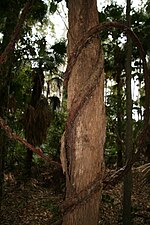
Afgekia is a small genus of large perennial climbing shrubs native to Thailand in Asia, belonging to the family Fabaceae. They are reminiscent of the related genus Wisteria.

Callerya is a genus of flowering plants in the legume family, Fabaceae. It belongs to the subfamily Faboideae, tribe Wisterieae. It includes 12 species native to the eastern Himalayas, Indochina, southern China and Taiwan, and Peninsular Malaysia. Its species are climbers, generally reaching up to about 1 m (3 ft) tall. The genus has a somewhat complicated taxonomic history; its circumscription was substantially revised in 2019.
Endosamara is a monotypic genus of flowering plants in the legume family Fabaceae, tribe Wisterieae. Its only species is Endosamara racemosa, a liana found from South India through Indo-China to the Philippines.
Sarcodum is a genus of flowering plants in the legume family, Fabaceae. It belongs to the subfamily Faboideae, tribe Wisterieae. Its three species are twining vines growing over shrubs, and are native from southeast mainland China to the Solomon Islands.

The tribe Millettieae is one of the subdivisions of the plant family Fabaceae.

Austrocallerya megasperma, one of several species commonly known as native wisteria, is a species of flowering plant in the family Fabaceae and is endemic to eastern Australia. It is a woody climber with pinnate leaves and racemes of purple, pea-like flowers.
Padbruggea is a genus of flowering plants in the family Fabaceae. Its native range stretches from southern China to western Malesia.

Whitfordiodendron is a genus of flowering plants in the legume family, of Fabaceae. It belongs to the subfamily Faboideae.

Adinobotrys is a genus of flowering plant in the family Fabaceae, native to from Indo-China to western Malesia. The genus was first described in 1911.

Wisteriopsis is a genus of flowering plants belonging to the family Fabaceae. Its native range is China to Indo-China and Temperate Eastern Asia. Wisteriopsis species are twining woody vines, generally resembling species of Wisteria. The genus was established in 2019 as a result of a molecular phylogenetic study, and includes species formerly placed in Millettia or Callerya.

Nanhaia is a genus of flowering plants belonging to the family Fabaceae. Its native range is Southern China to Northern Vietnam.

Wisterieae is a tribe of flowering plants in the bean family Fabaceae. The tribe was first described in 1994 for the sole genus Wisteria, but was greatly expanded in 2019 to include 13 genera, six of which were new. Five had previously been placed in the tribe Millettieae. Members of the tribe are climbers of various kinds. Some, like Wisteria, are cultivated for their flowers.
Sigmoidala is a monotypic genus of flowering plants in the family Fabaceae, first established in 2019. Its only species is Sigmoidala kityana, native to Myanmar, northern Thailand and Laos. It was first described by William Grant Craib in 1927 as Millettia kityana.
Kanburia is a genus of flowering plant in the family Fabaceae, native to Thailand. The genus was established in 2019. Kanburia species are twining woody vines.
Serawaia is a monotypic genus of flowering plants in the family Fabaceae, first established in 2019. Its only species is Serawaia strobilifera, endemic to Borneo. The species was first described in 1994 as Callerya strobilifera.

Wisteriopsis japonica is a species of flowering plant in the family Fabaceae, native to Japan, Korea, and the Ryukyu Islands. It was first described in 1839 as Wisteria japonica.

Wisteriopsis reticulata is a species of flowering plant in the family Fabaceae, native to mainland China, Hainan, Taiwan and Vietnam. It was first described by George Bentham in 1852 as Millettia reticulata. Anne M. Schot moved it to Callerya reticulata in 1994, then as a result of a molecular phylogenetic study in 2019, it was moved to the newly created genus Wisteriopsis. It has become naturalized in parts of Florida and Japan.
Villosocallerya bonatiana is a species of flowering plant in the family Fabaceae, native to south-central and southeastern mainland China, Laos and Vietnam. It is the sole species in genus Villosocallerya. The species was first described in 1910 as Millettia bonatiana.

Austrocallerya pilipes, synonym Callerya pilipes, is a species of flowering plant in the family Fabaceae, endemic to Queensland, Australia. It is a robust twining vine, climbing up trees and shrubs. It is known as the northern wistaria.

Austrocallerya australis, commonly known as native wisteria, blunt wisteria or Samson's sinew in Australia, is a species of flowering plant in the family Fabaceae, native to north-eastern Australia, New Guinea and some Pacific Islands. It is a tall, woody climber with pinnate leaves, the leaflets oblong, elliptic or egg-shaped, and panicles of purple, pea-like flowers.














